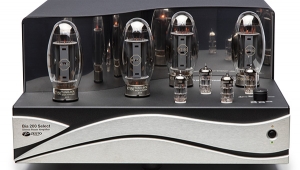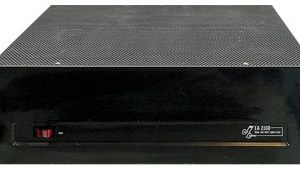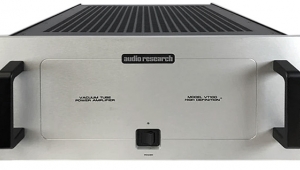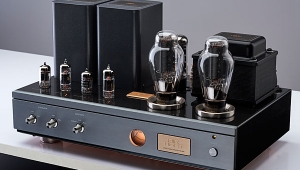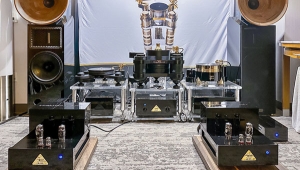| Columns Retired Columns & Blogs |
Audio Research D-160B power amplifier

The Audio Research D-160B has been heavily modified since the D-160A, and uses the same technology as the D-70, D-115, and D-250. It embodies William Z. Johnson's latest transformer and power supply designs, his latest choice of capacitors and resistors, and the same independent regulation of screens, drivers, and front end. D-160s and D-160As can be converted to D-160Bs for $1500.
In terms of physical layout, the D-160B is large and impressive-looking. It is quasi rack-mountable—you need braces to support the back. The D-160B uses quiet fans and has an LED power readout which is useful as a clipping indicator. The amplifier warns you if the rail fuses go. The D-160B has easily adjustable bias, with rear-panel metering.
The GE6550 output tubes originally supplied with earlier units of the 0-160B were prone to failure. ARC has solved this by going to different types of tubes, but ARC tube failures can be messy and require circuit-board cleaning and resistor replacements (a one- to two-hour job). I would advise getting new tubes from ARC if you have the old GEs in your D-160; my GE blew dramatically and you won't want the downtime and service problems. Above all, never feed a large input signal into a tube amplifier with the speakers disconnected.
Even the best quality control procedures cannot protect you from the problems in today's tubes or the effects of power-line voltage fluctuation. Check your power line for the required voltage; if you run into problems, call your electrician or power company. Quite often a transformer on your local line may be malfunctioning due to age or a lightning strike.
You might consider the equipment made by Electronic Specialists Inc. (171 South Main Street, Box 389, Natick, Massachusetts, 01760. They sell a wide range of quiet line filters, power interrupters, and regulator transformers-although they sure ain't cheap. SOLA makes some good devices, but most hum along with the tune in ways that Linn would distinctly discourage. Consult with ARC before buying any given device; some can shut down your system in ways that may not be good for its life.
The D-160B should have a heavier terminal strip with raised barriers for connecting speaker leads. Choose your lugs very carefully, dress them to avoid shorts, use Tweek, and screw down hard. Monster Cable Interlink interconnects work well with the ARC gear, as does the Discrete Audio cable.
Sound Quality
The D-160B is a much better amplifier than the D-160A. There is far more coherence between bass, midrange, and top. The bass is linear and well controlled, and the highs are extended and clean without any hardness. Both frequency extremes blend smoothly into the midrange, and dynamics are excellent.
The best tube and transistor units have been converging in their virtues, and that both the C-J and ARC sets of equipment share two important sonic limitations. The first is in the bass. Tube amplifiers have less ability than transistor amplifiers to provide the mix of output impedance and power that best controls a speaker in the deep bass. This is true simply with cone speakers; electrostatics and most planar speakers also perform much better in the deep bass with those transistor amplifiers that combine high damping factor, high power reserves, and the ability to drive low-impedance loads.
I don't mean to imply that the ARC's bass isn't good. It is remarkably real in the mid and upper bass, and provides a realism and transient detail in the upper bass that are missing from most transistor units. There is less bloom, less tendency to emphasize a fixed part of the bass spectrum, and does not make the trade-off between tightness and dynamic power that is common in many transistor units. The deep bass is one of the major thrills of the high end, however, and here the better transistor units walk away with superior performance. They have power and control in the deep bass; tube units do not.
The D-160B provides exceptional transparency, imaging, dynamics, air, and musicality. It doesn't sound precise to say that it will consistently provide new levels of natural musical detail on record after record, but it's true. That is why an amplifier like this is worth the extra money. You pay for superior resolution in a highly enjoyable form, and not for the name, the technology, or the extra heat.
While the Contrad-Johnson Premier Four is strongest in the midrange, the D-160B is superior in the highs. If both amplifiers are given about two hours to warm up (the ARC is much more sensitive in this regard than the C-J), and are biased exactly as specified, the similarities are more important than the differences.
I will, however, give the D-160B a slight edge in controlling bass and in low-bass accuracy (although this may simply be a function of its greater power), and the highs are more linear and detailed. The Premier Four gets the edge in the midrange, and in the aspect of imaging that gives the best hall effects and centerfill. The differences are not so great, however, that I would throw another 200 words at them.
Conclusion
The Audio Research D-160B is an example what the High End is all about. It belongs to that elite group of equipment which leads the way towards filling the awkward gap between live performances and reproduced sound, and which allows you to explore nearly 100 years of recorded sound to its best potential. Like virtually all high-end equipment, it is a luxury and not a cost-effective investments. While some of the best things in life may be free, none of them are cost-effective.
- Log in or register to post comments
